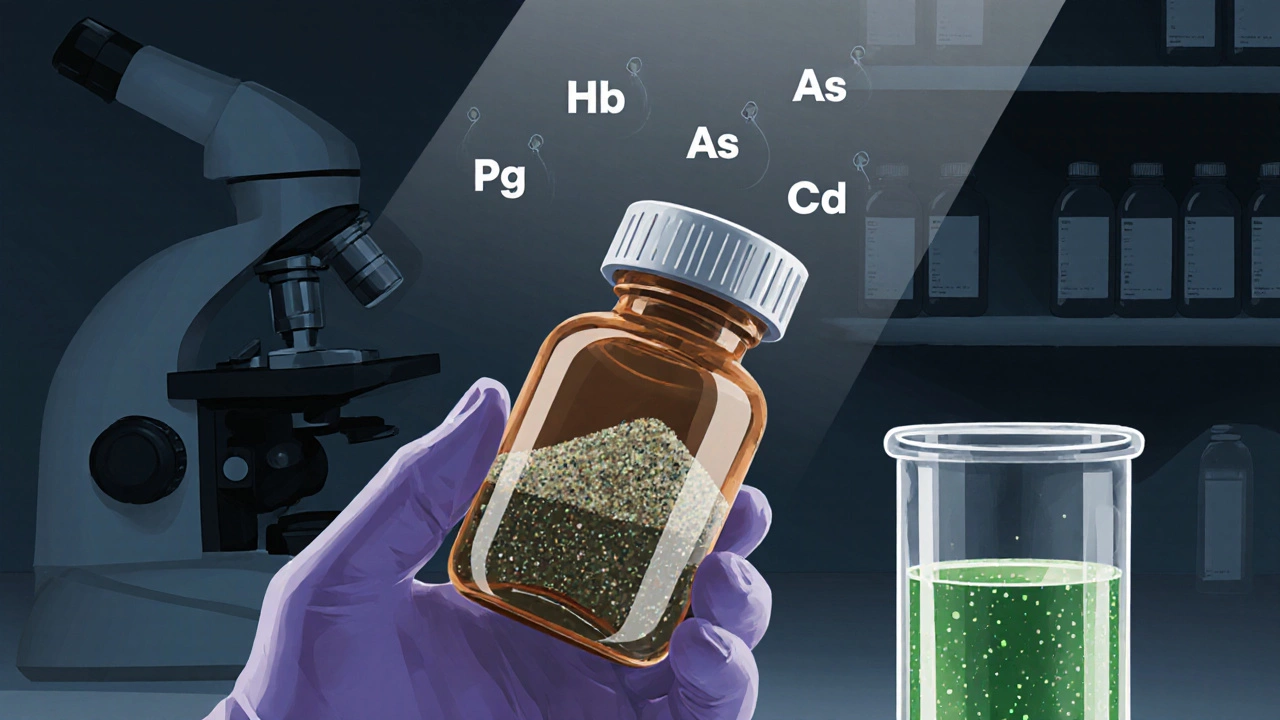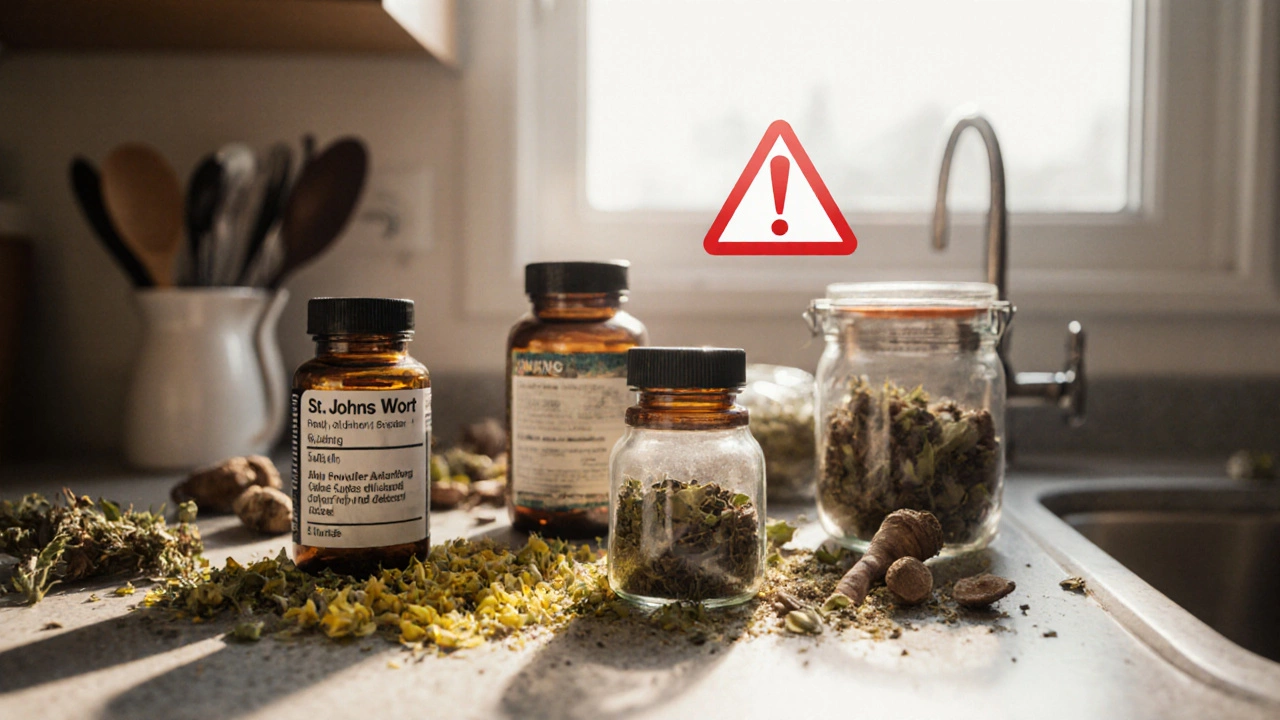Herbal Supplement Interaction Checker
Check for Potential Interactions
Enter your prescription medications and herbal supplements to see if they may interact. This tool is for informational purposes only and should not replace professional medical advice.
Key Takeaways
- Herbal supplements aren’t uniformly regulated, leading to quality and safety gaps.
- Contamination, incorrect dosages, and hidden additives are common problems.
- Many herbs interact with prescription drugs through Cytochrome P450 enzymes a family of liver enzymes that metabolize most medications, altering drug efficacy.
- Allergic reactions and adverse effects can be severe, especially with potent herbs like Kava kava a sedative herb linked to liver toxicity.
- Choosing reputable brands and consulting healthcare professionals reduces risk.
What Are Herbal Supplements?
When people talk about herbal supplements dietary products derived from plant parts-leaves, roots, seeds, or bark-intended to support health or treat minor ailments, they often assume “natural” equals “safe.” In reality, the market is a patchwork of ingredients, processing methods, and claims. Understanding the downsides helps you separate hype from genuine benefit.
Lack of Uniform Regulation
Unlike prescription drugs, herbal supplements fall under the FDA the U.S. Food and Drug Administration, which classifies supplements as foods rather than medicines. This means manufacturers don’t need to prove safety or efficacy before selling. Similar gaps exist in many countries, even though the European Medicines Agency sets standards for herbal medicines in the EU, but many products still bypass rigorous testing. The result? Variable quality and hidden risks.
Contamination and Adulteration
Studies have found that up to 30% of tested supplements contain heavy metals, pesticides, or undisclosed pharmaceutical compounds. Heavy metal contamination the presence of lead, mercury, arsenic, or cadmium in plant material often occurs because plants absorb these elements from polluted soil. Adulteration-adding synthetic drugs to boost claimed effects-has been documented with weight‑loss and sexual‑enhancement products, exposing users to unexpected side effects.

Inconsistent Dosage and Potency
Because the active ingredients in herbs can fluctuate with harvest time, climate, and processing, two bottles labeled the same can deliver vastly different amounts of the key compound. For example, the concentration of hypericin in St. John's Wort a herb used for mild depression varies by up to 400% between batches. Without standardized dosing, users may either get no benefit or experience toxicity.
Drug-Herb Interactions
Many herbs either induce or inhibit Cytochrome P450 enzymes the liver's drug‑metabolizing enzymes, changing how prescription medicines work. Notable examples:
- St. John's Wort accelerates the breakdown of antidepressants, oral contraceptives, and antiretrovirals, reducing their effectiveness.
- Ginkgo biloba can increase bleeding risk when combined with blood thinners like warfarin.
- Kava kava heightens sedation when taken with benzodiazepines or alcohol.
These interactions are often under‑reported because supplement labels don’t list potential drug conflicts.
Allergic Reactions and Adverse Effects
Even “mild” herbs can provoke severe allergic responses, especially in sensitized individuals. Kava kava a sedative herb linked to liver toxicity has caused cases of acute hepatitis and, in rare instances, liver failure requiring transplantation. Ginkgo biloba commonly used for memory support may trigger skin rashes or gastrointestinal upset. The lack of standardized testing means these risks stay hidden until they manifest.

Misleading Health Claims & Lack of Clinical Evidence
Manufacturers frequently market supplements with bold promises-"boost immunity," "burn fat," or "cure anxiety"-without substantial peer‑reviewed studies. While some herbs have centuries‑old anecdotal use, modern clinical trials often reveal modest or no benefit. Relying on unproven claims can delay seeking proper medical care, especially for chronic conditions.
How to Reduce Risks When Using Herbal Supplements
- Choose brands that follow Good Manufacturing Practices (GMP) and provide third‑party testing reports.
- Check for certifications from reputable labs (e.g., NSF International, USP).
- Consult your physician or pharmacist, especially if you take prescription drugs.
- Start with the lowest effective dose and monitor for any side effects.
- Avoid products that claim to treat serious diseases or that lack ingredient transparency.
Common Herbs with Notable Risks - Quick Reference
| Herb | Typical Use | Known Risks | Key Interaction |
|---|---|---|---|
| St. John's Wort | Depression, mood support | Photosensitivity, reduced drug levels | Oral contraceptives, antidepressants |
| Ginkgo biloba | Memory, circulation | Bleeding, gastrointestinal upset | Warfarin, antiplatelet drugs |
| Kava kava | Anxiety, sleep aid | Liver toxicity, sedation | Benzodiazepines, alcohol |
| Echinacea | Immune boost | Allergic reactions, autoimmune flare-ups | Immunosuppressants |
| Yohimbe | Libido, weight loss | High blood pressure, heart rhythm issues | Antihypertensives, stimulants |
Frequently Asked Questions
Can herbal supplements replace prescription medication?
No. While some herbs may offer mild symptom relief, they are not proven to treat serious conditions and can interfere with prescribed drugs.
How can I verify the quality of a supplement?
Look for third‑party testing certificates, batch numbers, and compliance with GMP standards. Reputable brands often post lab results on their websites.
Are there any herbs that are completely safe?
Safety is dose‑dependent. Even traditionally safe herbs like chamomile can cause allergic reactions in sensitive individuals.
What should I do if I experience an adverse reaction?
Stop taking the product immediately, document symptoms, and seek medical advice. Reporting the incident to health authorities helps improve safety monitoring.
Do herbal supplements contain the same amount of active ingredients every time?
No. Plant variability, harvesting methods, and processing lead to fluctuating levels of the active compounds.
